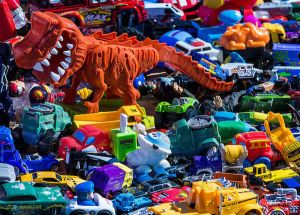[ad_1]
It happens every year. Well meaning relatives and parents who delight in seeing their children’s eyes light up on Christmas morning will inevitably purchase toys that end up being loud, obnoxious and downright annoying to the ears. But at what point does the noise level become unsafe?
Fortunately the Sight and Hearing Association (SHA) has released their 19th Annual Noisy Toys List, pinpointing toys not designed in accordance with safety guidelines for decibel (dB) level. You might think a toy is safe simply because it has been designed to meet the standard set by the American Society of Testing and Materials, which mandates that the sound-pressure level produced by toys shall not exceed 85 dB at 50 cm from the surface of the toy. However these standards were designed with adults in mind; children’s arms are much shorter than adults’ arms, and most children tend to bring toys close to their ears while playing.

this year? We’ve got the scoop on the
noisiest toys!
Anything over 85 decibels can cause cumulative damage to a child’s hearing; that means the damage might not be noticed right away but instead builds up over time, causing hearing loss down the road. That is why it is so important that we pay close attention to the noise levels to which children are exposed. You can see the entire list from the SHA here, but we meanwhile have broken out some of the top hearing offenders for 2015.
Who doesn’t love the favorite children’s song “Five Little Monkeys Jumping on the Bed?” Not the SHA, and you won’t either if you buy Jumpin’ Lil Monkeys from Animal Babies Nursery. The number one offender on this year’s list is a cuddly bedtime toy, meant to be played with and snuggled right up next to your child’s ear. Adorable accessories include a diaper, juice box and a cookie; what is not listed as an accessory? Potential hearing damage. This adorable toy peaked at 103.4 dB, which is equivalent to that of a power lawn mower. Our advice? Stick to “Twinkle Twinkle, Little Star” and leave this toy on the shelf.
The second loudest toy on this year’s list is one that would be almost impossible for a child to resist: The Cool Tunes Sing-along Boombox, from the wildly popular movie “Frozen.” Featuring three of the hit songs from the movie plus a dock for an MP3 player, this music player tops out at over 100 dB. That is the approximate decibel level of a jackhammer, enough to cause permanent hearing damage. The other bad news is that the manufacturers recommend this toy for children as young as three, too young to self-monitor volume level. Save the music players for when your kids are older; you’ll be glad you did.
Third on the list is a toy that is alarmingly marketed for infants as young as six months. The Lil’ Ocean Explorers Push ‘n Glow Fish from Little Tykes advertises “fun sounds and lights with the press of a button on the handle,” yet those “sounds” registered an astonishing 93.8 dB when held near the ear. That is equivalent to the noise level of a tractor, which certainly doesn’t sound like fun to us. Of particular concern is that babies have thinner skulls, which means the cochlea is less protected from harmful noise. Bottom line? This is one fish you won’t mind letting get away.
Though you can’t do much about the set of bagpipes from Aunt Phyllis (except make it “disappear” after the holidays), there are steps you can take when shopping for your children or other children to make sure you purchase toys which meet decibel safety guidelines and keep a child’s hearing safe.
- First, and most importantly, read the product reviews carefully before shopping. Consumers who have purchased these toys are not shy about making note of uncomfortably loud volume levels.
- Make sure to test a toy before you buy it. If a toy is interactive, it most likely has a button that says “Try Me.” This will not only allow you to experience what it will be like to have the toy in your home, but also to assess the volume level. A good rule of thumb is that if it seems too loud for you, it is too loud for your child.
- Check for a volume control knob; any toy that is too loud and does not give the option to turn it down should not go into your cart.
- Before you hit the toy store, consider downloading a sound level meter app on your phone. That will allow you to test a toy’s actual noise level prior to purchase.
- If you purchase a toy that is too loud, there is a simple fix. Just put clear packing tape over the speaker to muffle the volume and bring the toy back to a volume level that is safe for little ears.
So be sure to save your child’s hearing, and perhaps your own sanity, by avoiding these toys this holiday season. Because healthy hearing is the greatest gift of all.
[ad_2]
Source link

